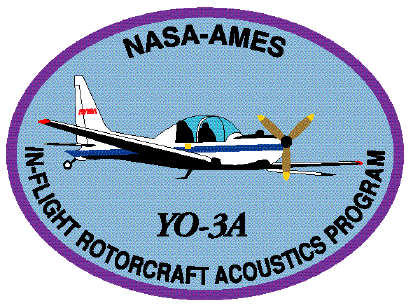IN-FLIGHT ROTORCRAFT ACOUSTICS PROGRAM

Introduction
A key part of NASA's aeronautics research is reducing noise to make helicopters and tiltrotors more acceptable to the public. The objective of the In-Flight Rotorcraft Acoustics Program (IRAP) is to acquire rotorcraft noise data in flight for comparison to wind tunnel data. The type of noise of concern is "blade-vortex-interaction," or BVI, noise. Microphones on the wing tips and tail fin of the quiet NASA YO-3A Acoustics Research Aircraft measure BVI noise while the YO-3A descends in close formation with the helicopter or tiltrotor emitting the noise. The data acquired through IRAP is needed to validate wind-tunnel test results, or, where the results cannot be validated, to provide researchers with clues as to how to improve testing methods.
BVI noise
During certain rotorcraft flight operations, particularly forward descents such as landing approaches, each rotor blade can run into the tip vortex shed by a preceding blade. The resulting "blade-vortex interaction," or BVI, causes a distinctive type of noise: the annoying "blade-slap" of helicopters with slow-turning rotors, or a sharp fluttering noise for rotorcraft with fast-turning rotors. A comprehensive review of rotorcraft noise is given in Schmitz's 1991 summary, listed on the references page. In-flight measurement of BVI noise is the primary effort of IRAP.
History
In-flight measurements of BVI noise were undertaken in the mid-1970s with a Bell UH-1H "Huey" as the test helicopter and an OV-1 Mohawk as the microphone platform (Schmitz, 1991). By 1979, the OV-1 had been replaced by the much quieter YO-3A, which was used to measure BVI from a UH-1H and two models -- AH-1S and AH-1G -- of Bell Cobra helicopters (Boxwell and Schmitz, 1980; Cross and Watts, 1984). The Army further used the YO-3A to test a variety of helicopters, including the UH-60, YUH-61, YAH-63, and AH-64 (Cross and Watts, 1984). There were also flight tests with a McDonnell Douglas MD 500D.
Drawing on this experience with in-flight acoustics testing, the In-Flight Rotorcraft Acoustics Program (IRAP) was established in 1991 for the specific purpose of acquiring measurements of rotor noise in flight for comparison to wind-tunnel data. IRAP is managed by the Rotorcraft Aeromechanics Branch at NASA Ames Research Center. The YO-3A has been used for all IRAP tests, four of which have been carried out to date:
Sikorsky S-76C (1991 and 1992)
MBB BO 105 (1993)
Sikorsky UH-60A (1993-94)
Bell XV-15 (1995)
Follow the links for details of each flight test. Each discussion of a flight test program includes links to hypertext descriptions of associated wind tunnel tests.
Related Publications:
Boxwell, D. A., and Schmitz, F. H. "Full-Scale Measurements of Blade-Vortex Interaction Noise." 36th Annual Forum of the American Helicopter Society, Washington D.C., May 1980.
Cross, J. L. and Watts, M. E. "In-Flight Acoustic Testing Techniques Using the YO-3A Acoustic Research Aircraft." NASA TM-85895, February 1984.
McCluer, M. and Dearing, M. "Measuring Blade-Vortex Interaction Noise Using the YO-3A Acoustics Research Aircraft." 22nd European Rotorcraft Forum, Brighton, UK, September 1996.
Schmitz, F. H. "Rotor Noise." Acoustics of Flight Vehicles: Theory and Practice. Vol. 1: Noise Sources. H. H. Hubbard, ed. NASA RP-1258, WRDC TR-90-3052, August 1991.
See also the references page.
Point of Contact:
Dr. Gloria Yamauchi
NASA Ames Research Center
Moffett Field CA 94035-1000